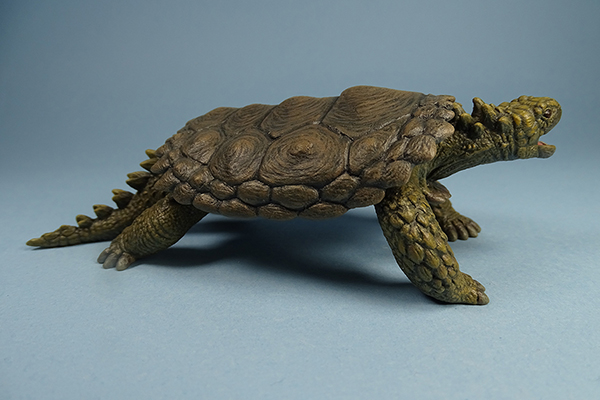
Review and photographs of Proganochelys quenstedti (Vitor Silva) by stemturtle, edited by Suspsy

More than twenty years ago, I saw a wonderful reconstruction of Proganochelys at the American Museum of Natural History in New York City. Ever since then, I have searched for a realistic model of that species for my collection. Finally, my wish came true.


Proganochelys quenstedti was sculpted in cold porcelain by Vitor Silva of Brazil, whose paleoart is featured on DeviantArt. Each sculpture is unique, not mass produced. Production was delayed for several years during the pandemic, but this masterpiece was worth the wait. Although Proganochelys is listed at 1:4 scale, I commissioned my model at 1:7. Total length is about 5.4 inches or 13.8 cm. A live specimen would have been about 36 inches or 91 cm.


This stem-turtle has an extra row of scutes on the margins of the carapace to protect the legs. There are spines on the neck and tail. The three distal osteoderms of the tail are fused together, serving as a club. The head was not retractable into the carapace except sideways. There is a beak to harvest vegetation. The mouth is open, revealing an absence of teeth on the jaws, but there are denticles on the palate. The color of the skin is light brown with a dark gray carapace, similar to a snapping turtle.


Proganochelys lived about 210 million years ago in the Late Triassic. Initially thought to have been semi-aquatic, it may have been terrestrial instead, based on its short hands. Fossils have been found in Germany. Another species, P. rughae, found in Thailand, has been reclassified as Thaichelys rughae. Chinlechelys tenertesta, a cousin of Proganochelys with a very thin carapace, is from New Mexico.

One of the wonders of evolution is how the turtle was able to breathe during the enclosure of the shoulder girdle inside of the rigid shell. Abdominal muscles instead of intercostal muscles became responsible for ventilation. Proganochelys is one of the first turtles with a complete shell, ten million years after Odontochelys semitestacea. Odontochelys had a plastron, but lacked a hard carapace. See a review of it on this blog.

I recommend the beautiful art of Vitor Silva. The fable of the tortoise and the hare teaches us that slowly but surely wins the race.
Disclaimer: links to Ebay and Amazon on the DinoToyBlog are affiliate links, so we make a small commission if you use them. Thanks for supporting us!
Trending Products










